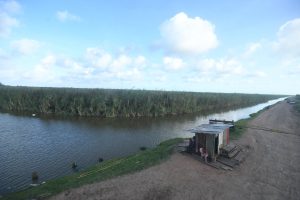— 3,900 hectares of land to be harvested; three methods to be utilised
HARVESTING has started in the country’s sugar belt, with the first set of sugarcane set to be reaped today at the Albion Sugar Estate.
In the coming weeks, cane harvesters and machines will be dispatched across the estate to harvest 3,900 hectares of land.
Albion Estate, one of three producing sugar estates, is currently the country’s largest producer of sugar, and this is expected to continue in the near term, as the output from the 3,900 hectares of land is anticipated to be 261,000 tonnes of cane.
“Out of that we expect to produce in excess of 21,750 tonnes of sugar, with a TCTS [tonnes cane to tonnes sugar] average of 12.5,” Manager of the Albion Estate, Threbhowan Shivprasad said during a comment following a tour of the estate, on Thursday.
This crop will last for about 12 weeks, ending in May with the estate hopefully reaching its target of 21,750 tonnes of sugar, which is about 50 per cent of its total production. This will form part of the industry’s annual production target of 98,000 metric tonnes of sugar.
To help achieve this overarching target, the Blairmont Sugar Estate will be producing 27,940 metric tonnes of sugar, while Uitvlugt will be looking to churn out 20,517 metric tonnes of sugar.

At Albion, Shivprasad said the estate, in addition to employing the manual/traditional method of harvesting [cane harvesters], will be taking a semi-mechanical approach, which will involve the use of bell loaders.
The other method outlined by the manager is mechanised harvesting, which, once fully operationalised, will be used to harvest 40 tonnes cane per hour.
“With that kind of harvesting, you can do harvesting around the clock,” Shivprasad said, adding, however, that the layout of the fields will have to be adjusted.
Despite the move towards mechanisation, authorities gave the assurance that sugar workers will remain an integral part of the operations of the Guyana Sugar Corporation (GuySuCo).
Human Resources Manager at the Albion Sugar Estate, Vemen Walter, said the factory currently employs 3,407, while there are 1,204 harvesters.
In 2017, the former A Partnership for National Unity + Alliance For Change (APNU+AFC) coalition government announced the closure of several sugar estates across the country; the move saw four sugar estates being closed, and 7,000 sugar workers losing their jobs.
But, as said by Agriculture Minister, Zulfikar Mustapha, plans are afoot to return the industry to viability through coordinated and prudent management.
“We have already employed 1,000 persons who they [APNU+AFC] dismissed. And, in the New Year [2021], we will employ another 3,000 workers and I am optimistic that, in the first crop of 2022, we will produce sugar once again at those estates.
“They [APNU+AFC] have brought the estates to their knees, so we have to capitalise and bring the estates to a break-even point… there are opportunities in the Caribbean and it will also create more employment for the people,” said the Agriculture Minister.
The Rose Hall Estate will be the first of the three estates to be reopened and is expected to begin grinding in 2022.




.png)









